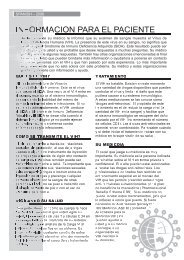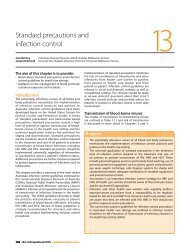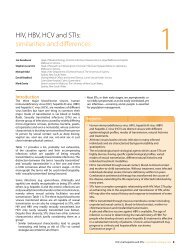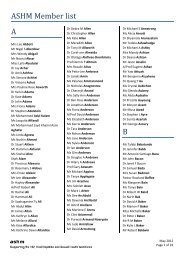B Positive – all you wanted to know about - ASHM
B Positive – all you wanted to know about - ASHM
B Positive – all you wanted to know about - ASHM
Create successful ePaper yourself
Turn your PDF publications into a flip-book with our unique Google optimized e-Paper software.
2 Virology: viral replication and drug resistance<br />
as discussed previously, because HbV uses<br />
reverse transcription <strong>to</strong> copy its genome (rna<br />
� dna) and the viral rt lacks a proof-reading or<br />
editing function, many ‘mistakes’ are introduced<br />
in<strong>to</strong> the newly replicated HbV dna, resulting<br />
in substantial diversity in the viral genome. as<br />
discussed below, this gives the virus a great<br />
survival advantage as every single nucleotide<br />
in the viral genome of 3200 base-pairs is<br />
mutated or changed every day. thus, single<br />
and double mutations associated with antiviral<br />
drug resistance exist even before therapy is<br />
introduced. However, three or four mutations in<br />
the HbV dna that would be needed <strong>to</strong> escape<br />
na treatment are very unlikely <strong>to</strong> be found<br />
pre-therapy. these observations are the basis<br />
for the use of combination chemotherapy for<br />
chronic viral diseases (such as HiV, aids, e.g.:<br />
Highly active antiretroviral therapy [Haart]).<br />
Common mutants of HBV<br />
1. Mutations affecting HBeAg<br />
as well as Hbcag and Hbsag, the HbV also<br />
encodes for an accessory protein, the hepatitis<br />
b e antigen (Hbeag). the Hbeag protein is a<br />
soluble form of the Hbcag and is thought <strong>to</strong><br />
act as a <strong>to</strong>lerogen. 4 the Hbeag is classified as<br />
an accessory protein of HbV, since the virus<br />
can replicate without an Hbeag. However, the<br />
production of Hbeag is an important strategy<br />
for the virus <strong>to</strong> help avoid immune elimination<br />
by the host’s immunological response. When<br />
put under the immunological pressure of<br />
Hbeag seroconversion, which is part of the<br />
natural his<strong>to</strong>ry of cHb, HbV has a number of<br />
ways of ‘escaping’ such pressure.<br />
two major groups of mutations have been<br />
identified which result in reduced or blocked<br />
Hbeag expression.<br />
the first group refers <strong>to</strong> mutations that affect<br />
the basal core promoter (bcP) typic<strong>all</strong>y at<br />
nucleotide (nt)1762 and nt1764, resulting<br />
in a transcriptional reduction of the Pre-c/<br />
cmrna. 5 Mutations in the bcP, such as a1762t<br />
plus G1764a, may be found in isolation or<br />
in conjunction with precore mutations (see<br />
below). the double mutation of a1762t plus<br />
G1764a results in a significant decrease in<br />
6 b <strong>Positive</strong> <strong>–</strong> <strong>all</strong> <strong>you</strong> <strong>wanted</strong> <strong>to</strong> <strong>know</strong> <strong>about</strong> hepatitis b: a guide for primary care providers<br />
Hbeag levels and has been associated with<br />
an increase in viral load. importantly, these<br />
bcP mutations do not affect the transcription<br />
of HbV pg rna or the translation of the core<br />
or polymerase protein. thus, by removing the<br />
inhibi<strong>to</strong>ry effect of the precore protein on<br />
HbV replication, the bcP mutations appear <strong>to</strong><br />
enhance viral replication by suppressing Pre-c/<br />
c mrna relative <strong>to</strong> pregenomic rna. 5<br />
the second group of mutations includes<br />
HbV mutants with a translational s<strong>to</strong>p codon<br />
mutation at nt position 1896 (codon 28: tGG;<br />
tryp<strong>to</strong>phan) of the precore gene. 6 the single<br />
base substitution (G-<strong>to</strong>-a) at nt1896 gives rise<br />
<strong>to</strong> a translational s<strong>to</strong>p codon (tGG <strong>to</strong> taG;<br />
taG = s<strong>to</strong>p codon) in the second last codon<br />
(codon 28) of the precore gene located within<br />
the ε structure of pgrna. the ntG1896 forms a<br />
base pair with nt1858 at the base of the stem<br />
loop. 6 other mutations have been found within<br />
the precore transcript, which block Hbeag<br />
production, including the abolition of the<br />
initiation codon methionine residue. 7<br />
2. Envelope gene mutations<br />
Viral genomes that cannot synthesise the<br />
envelope proteins have been found <strong>to</strong> occur<br />
frequently and are often the dominant virus<br />
populations in patients with chronic hepatitis<br />
b. 8 the envelope region overlaps the Pol protein<br />
(figures 2.2 a and 2.2 b).<br />
the existing hepatitis b vaccine contains<br />
the major Hbsag. the subsequent anti-Hbs<br />
response <strong>to</strong> the major hydrophilic region<br />
(MHr) of Hbsag located from residue 99 <strong>to</strong><br />
170 induces protective immunity. Mutations<br />
within this epi<strong>to</strong>pe have been selected during<br />
vaccination 9 and following treatment of liver<br />
transplant recipients with hepatitis b immune<br />
globulin (Hbig) prophylaxis. 10 Most vaccine-<br />
Hbig escape isolates have an amino acid<br />
change from glycine <strong>to</strong> arginine at residue 145<br />
of Hbsag (sG145r) or aspartate <strong>to</strong> alanine at<br />
residue 144 (sd144a). the sG145r mutation<br />
has been associated with vaccine failure 9 and<br />
has been shown <strong>to</strong> be transmitted and cause<br />
disease.






